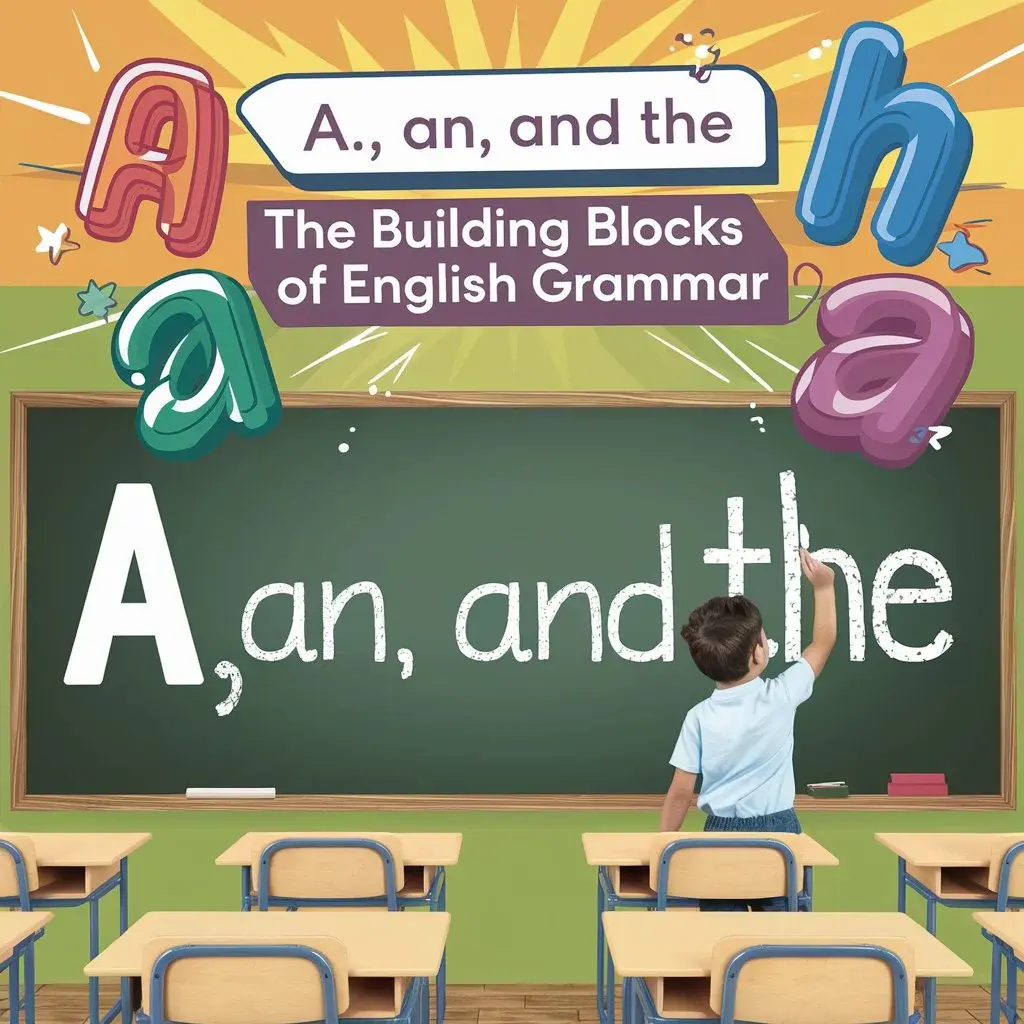Understanding when to use articles “a” or “an” for singular, non-specific nouns, and “the” for specific nouns is essential for clear communication. This guide will dive into the rules and nuances of these articles, providing clear examples along the way. By the end, you’ll confidently navigate the world of English articles with ease.
Articles in English grammar, such as “a,” “an,” and “the,” are small words with a big impact. They help us specify whether we’re talking about something specific or something more general.
What Are Articles?
Definition
Articles are small words in English that are used to indicate whether we are referring to something specific or something nonspecific. They are like little signposts that help us understand the context of a sentence. In English, there are three main articles: “the,” “a,” and “an.”
Definite Article: “The”
“The” is a definite article. It’s used when we’re talking about something specific, something that both the speaker and the listener know about or can easily identify.
Definite Article: “TheUsage Before specific nouns, before superlative adjectivesBefore, unique things or things that have been mentioned before
Examples:
- I saw the cat on the roof.
- She is the tallest girl in our class.
- Have you seen the book I was reading yesterday?
Indefinite Articles: “A” and “An”
“A” and “an” are indefinite articles. They are used when we’re talking about something nonspecific or something for the first time.
Indefinite Articles: “A” and “AnUsage Before singular, countable nounsBefore nonspecific nouns or when introducing something for the first time,A” is used before nouns that begin with a consonant sound”An” is used before nouns that begin with a vowel sound
Examples:
- I want a cat for my birthday.
- Can you pass me an apple?
- She bought a new car yesterday.
Rules for Using Articles in English
When communicating in English, it’s essential to grasp the nuances of article usage to convey meaning accurately. Here’s an extended explanation of the rules governing articles:
When to Use “The”
Using “the” adds specificity to a noun, indicating that the speaker is referring to a particular instance or set of instances. It’s crucial to remember these instances:
- Specificity: “The” is employed when talking about something specific, whether it’s a particular object, person, or concept that both the speaker and listener are familiar with or can easily identify.
- Uniqueness: “The” precedes unique things or those mentioned before in the conversation. For example, “the sun” refers to the specific star that illuminates our planet.
- Superlatives: When using superlative adjectives to denote the highest or lowest degree of a quality, “the” is used. For instance, “She is the tallest girl in the class.”
When to Use “A” or “An”
“A” and “an” are indefinite articles used to introduce nonspecific nouns or nouns mentioned for the first time. Here’s how to apply them correctly:
- Countable Nouns: These articles are used before singular, countable nouns, which are entities that can be enumerated. For example, “a cat” or “an apple.”
- Consonant and Vowel Sounds: “A” is placed before nouns starting with a consonant sound, while “an” is used before nouns commencing with a vowel sound. For instance, “a book” and “an umbrella.”
Omission of Articles
At times, articles are unnecessary, particularly with uncountable nouns and plural nouns used generically. Remember:
- Uncountable Nouns: These are substances, concepts, or phenomena that cannot be counted individually, such as “water” or “advice.” In such cases, no article is needed.
- Plural Nouns in General Sense: When referring to plural nouns in a broad or general manner, omitting the article is common. For instance, “Cats are mammals.”
Instances Where Articles Are Not Used
Articles may be omitted in specific contexts, including titles, names, and certain expressions. For example, “President of the United States” or “Bed Bath & Beyond.”
Common Mistakes with Articles
Recognizing and avoiding these common errors will enhance your article usage proficiency.
- Ambiguous Contexts: Failing to provide adequate context may lead to ambiguity in article usage.
- Overuse: Using articles excessively can clutter sentences and detract from clarity.
- Lack of Articles with Countable Nouns: Neglecting to include articles before countable nouns can result in unclear or incomplete statements.
- Incorrect Use of “A” and “An”: Misplacing “a” or “an” before nouns based on consonant or vowel sounds can lead to grammatical errors.
- Misplacement of Articles: Placing articles incorrectly within sentences may alter their intended meaning or render them grammatically incorrect.
20 Examples Illustrating Article Usage:
A, An, and The
- I saw the movie last night.
- Can you pass me a pencil?
- She is reading an interesting book.
- The sun rises in the east.
- He is the best player on the team.
- A dog barked loudly outside.
- She bought an umbrella because it was raining.
- The Eiffel Tower is in Paris.
- I need a cup of coffee in the morning.
- Have you seen the new iPhone?
- I need an onion for the recipe.
- The Statue of Liberty is a famous landmark.
- Can you get me a glass of water?
- She is wearing a beautiful dress.
- I found the keys you lost.
- He bought a ticket for the concert.
- The sky was clear and blue.
- She wants to be an astronaut when she grows up.
- I have a question for you.
- Did you read the article in the newspaper?
Exercise:
Instructions:
Fill in the blanks with the appropriate article: “a,” “an,” or “the,” or leave the space blank if no article is needed. Some sentences may require no article at all.
- I want to buy a new car.
- Have you seen the movie we watched last night?
- She is studying to become a doctor.
- Can you pass me some salt, please?
- We went to a zoo and saw lions.
- He is the best student in __________ class.
- I need a glass of water.
- Have you visited the Louvre Museum in Paris?
- I want to adopt a puppy from an animal shelter.
- She is reading an interesting article in a magazine.
- Did you see the cat that was on the roof?
- I need __________ advice on how to fix my computer.
- We are going to watch a basketball game tomorrow.
- Can you give me an apple from the fruit bowl?
- She bought a new dress for the _____ party.
- Have you ever been to the Great Wall of China?
- I need help with my homework.
- Did you see the shooting star last night?
- He wants to become an engineer when he grows up.
- I saw a bird in a __________ tree outside.
Answer Key:
- a
- the
- a
- the
- the, the
- the, the
- a
- the
- a, the
- an, a
- the, the
- some (no article needed)
- a
- an, the
- a, the
- the
- some (no article needed)
- a
- an
- a, the
FAQs
What are the 20 examples of articles?
Articles are words like “a,” “an,” and “the” that we use before nouns to indicate whether we’re talking about something specific or nonspecific. Here are 20 examples:
- I want a book.
- She bought an apple.
- He is the best player.
- They live in a house.
- Have you seen the movie?
- Can you pass me a pen?
- She is reading an interesting article.
- We visited the zoo and saw the lions.
- I need a cup of coffee.
- She bought a new dress.
- Have you read the book?
- They are going to the concert.
- He wants to be an astronaut.
- I have a question.
- Can you give me an umbrella?
- We watched the sunset.
- She found the keys.
- I need a computer.
- Have you visited the museum?
- She is wearing a necklace.
What is an example of a sentence using the article “the”?
Here are a few examples of sentences using the definite article “the”:
- The sun rises in the east.
- Have you seen the cat that was on the roof?
- I found the keys you lost.
- We visited the Eiffel Tower in Paris.
- The sky was clear and blue.
What not to do in an article?
When writing an article, it’s essential to avoid certain pitfalls:
- Lack of Clarity: Make sure your article is clear and coherent, avoiding ambiguity or confusion.
- Overgeneralization: Avoid making sweeping statements without providing evidence or context to support your claims.
- Plagiarism: Always cite your sources properly and refrain from copying content from other sources without permission.
- Ignoring counterarguments: Address opposing viewpoints or potential criticisms to provide a well-rounded perspective on the topic.
- Poor Organization: Ensure your article is well-structured, with clear introductions, body paragraphs, and conclusions.
When not to use an article?
Articles are not always necessary, especially in certain contexts.
- Names: Articles are typically omitted before the names of people, places, or organizations. For example, “John Smith,” “New York City,” or “Microsoft.”
- Titles: Titles of books, movies, songs, and other works often do not require articles. For example, “Harry Potter and the Philosopher’s Stone” or “The Lion King.”
- Generalizations: When referring to things in a general or abstract sense, articles may be omitted. For example, “dogs are loyal animals” or “love is a powerful emotion.”
How do you teach articles in grammar?
Teaching articles in grammar can be approached systematically:
- Introduce Concepts: Begin by explaining the purpose and types of articles (definite and indefinite).
- Provide Examples: Offer plenty of examples illustrating the usage of articles in different contexts.
- Practice Activities: Engage students in various exercises, such as fill-in-the-blank sentences, matching activities, and role-playing scenarios.
- Correct Mistakes: Provide feedback and corrections to help students learn from their errors and improve their understanding of article usage.
- Review and Reinforce: Continuously review and reinforce article usage through regular practice and application in writing and speaking tasks.
How do you teach articles to beginners?
Teaching articles to beginners requires simplicity and repetition.
- Start with the basics: Begin by introducing the concept of articles and distinguishing between “a/an” and “the.”
- Use Visual Aids: Incorporate visuals such as pictures or flashcards to help reinforce understanding.
- Practice with Concrete Examples: Use concrete nouns and familiar objects to demonstrate article usage in context.
- Provide scaffolded activities: Offer guided practice activities with gradually increasing complexity to build confidence and proficiency.
- Encourage Oral Practice: Encourage students to practice using articles in spoken sentences and conversations to reinforce learning.
Final tips
In conclusion, mastering the usage of articles is essential for effective communication in English. By understanding when to use the definite article and when to opt for an indefinite article, writers can enhance clarity and precision in their writing.
Additionally, avoiding common mistakes such as overuse or omission of articles ensures that messages are conveyed accurately. With practice and attention to detail, individuals can confidently navigate the nuances of article usage and craft compelling and articulate content.

It’s Elara Winters, your guide at “Grammer Grove.” I’ve dived into the intricacies of crafting the perfect English writing sections for your project, research paper, or thesis. With a wealth of experience in this field, I’m here to help you express gratitude and appreciation effectively. Join me on this journey, and let’s make your English writings shine!












